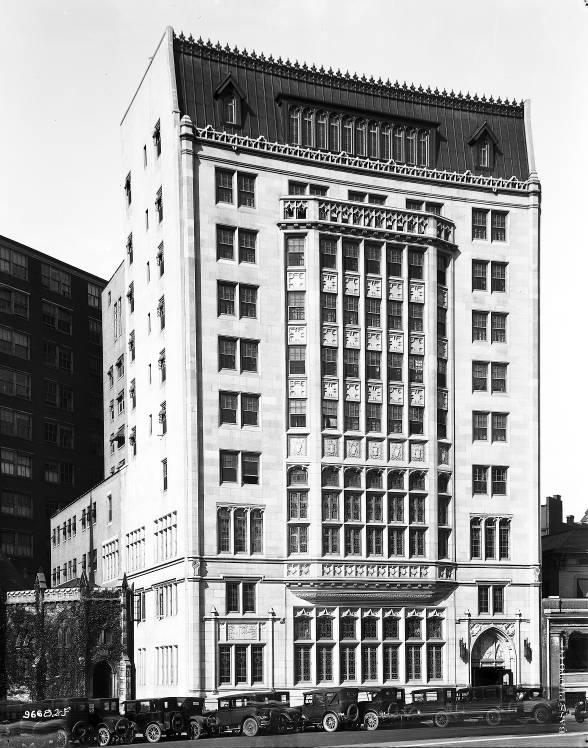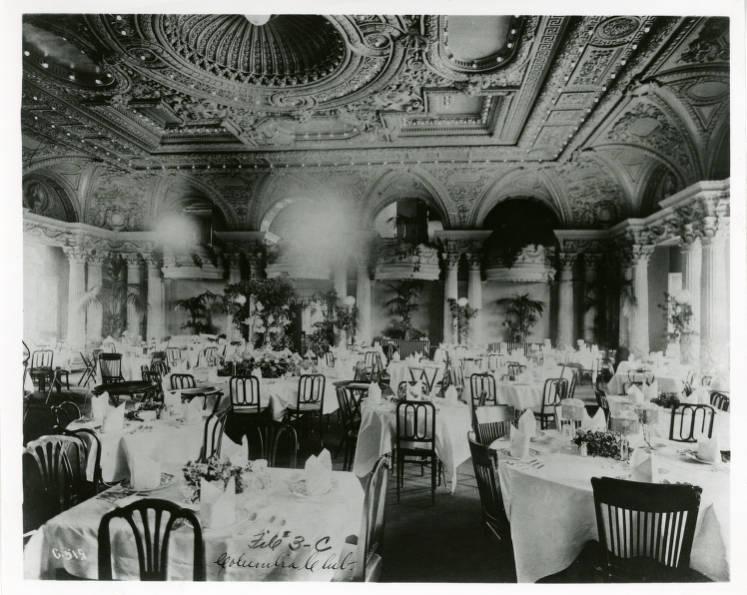The Columbia Club is a private club situated on in downtown Indianapolis. The current structure, the Club’s third home on the same site, was built in 1925.

Originally formed in 1888, a contingent of prominent Indianapolis Republicans established the Harrison Marching Society to endorse the candidacy of General of Indianapolis as the nation’s 23rd president. This group, the Harrison Marching Society, sporting decorative canes and attired in blue coats, gray vests, and silver derbies, welcomed dignitaries and delegations visiting Indianapolis during the campaign. Their grand processions to Harrison’s home on North Delaware Street, where he addressed the crowds, soon became the talk of the town.
The enthusiastic members of the Marching Society decided to secure a clubhouse and increase their numbers from 150 to 400. At the suggestion of , one of the organization’s original subscribers and future U.S. Senator and postmaster general, the club was renamed “Columbia” after the popular patriotic synonym for the United States. The Columbia Club was incorporated on February 13, 1889. One of the group’s objects, according to an early constitution, was to advance “the science of political economy and of politico-legal historical criticism from the standpoint of the Republican Party.” Other prominent members include , , and Hoagy Carmichael.
The original clubhouse stood on the Circle from 1889 to 1898. That structure was replaced with a five-story building which was ultimately razed to accommodate a growing membership.
The club’s third and present home, a ten-story architectural showplace designed by located on Monument Circle. Rubush and Hunter followed guidelines proposed by fellow architect William Earl Russ to design a structure complementary to the , and carried out its construction.

The Columbia Club showcases many hallmarks of the style exhibited in the monument, including a multi-story Oriel (bay window in an upper story supported from below by brackets) and influences seen in the window arches. The building also features panels carved by local sculptor , a local artist who made limestone carvings for other historic buildings on Monument Circle.
Inside the Columbia Club are numerous works of art and historic artifact, including items from the Benjamin Harrison presidential campaign and part of the family china collection. The Columbia Club added to its existing collection in 2004 after acquiring numerous works of art from the Indianapolis Athletic Club. It now boasts a large gallery of works by members of the of painters, including T. C. Steele, , and .
The club has hosted scores of distinguished visitors, from political figures to celebrities, including every Republican president from Harrison through George Bush. In 1976, then presidential-candidate Ronald Reagan spoke at the annual Beefsteak Dinner, a cherished tradition at the club since 1891. According to club records, secret meetings also were held at the club to negotiate the 1984 move of the Baltimore to Indianapolis.
Although the Columbia Club has deep GOP roots, it has evolved over the years to become less exclusively white, male, and Republican. A resolution to end racial discrimination passed the club’s board in the late 1960s, women were admitted to membership (and to the Harrison dining room, a male bastion) beginning in October 1979, and a Democrat was elected president of the organization in 1979.
In 1959, , who was director of the Metropolitan Planning Department, convened prominent community leaders, including , at the Columbia Club to discuss how best to preserve what was left of the built environment in Indianapolis. Indiana Landmarks was established as a result of this meeting.
Listed on the National Register of Historic Places in 1983, the building is located in the The building boasts four floors of overnight guest rooms, banquet facilities for private meetings and parties, a library, billiards room, barbershop, fitness center, and two dining rooms.
In 2012, the Columbia Club was selected as a Platinum Club of America, making it one of the 35 top-ranked city clubs in the nation and a premier club in the Midwest. In 2014, the Club celebrated its 125th anniversary with special events throughout the year. The celebrations began in March with the 125th Anniversary Gala, a reenactment of the Harrison Marching Society, a celebration of Harrison’s birthday, and an extravagant New Year’s Eve party celebrating the music of the last 125 years.
The nearly 90-year-old clubhouse maintains continuous updates and improvements to meet current and future member needs. Inside, members and guests of the Columbia Club enjoy a 20,000 square feet fully-equipped meeting and event space, more than 80 en-suite guest rooms, and five dining rooms.

Help improve this entry
Contribute information, offer corrections, suggest images.
You can also recommend new entries related to this topic.